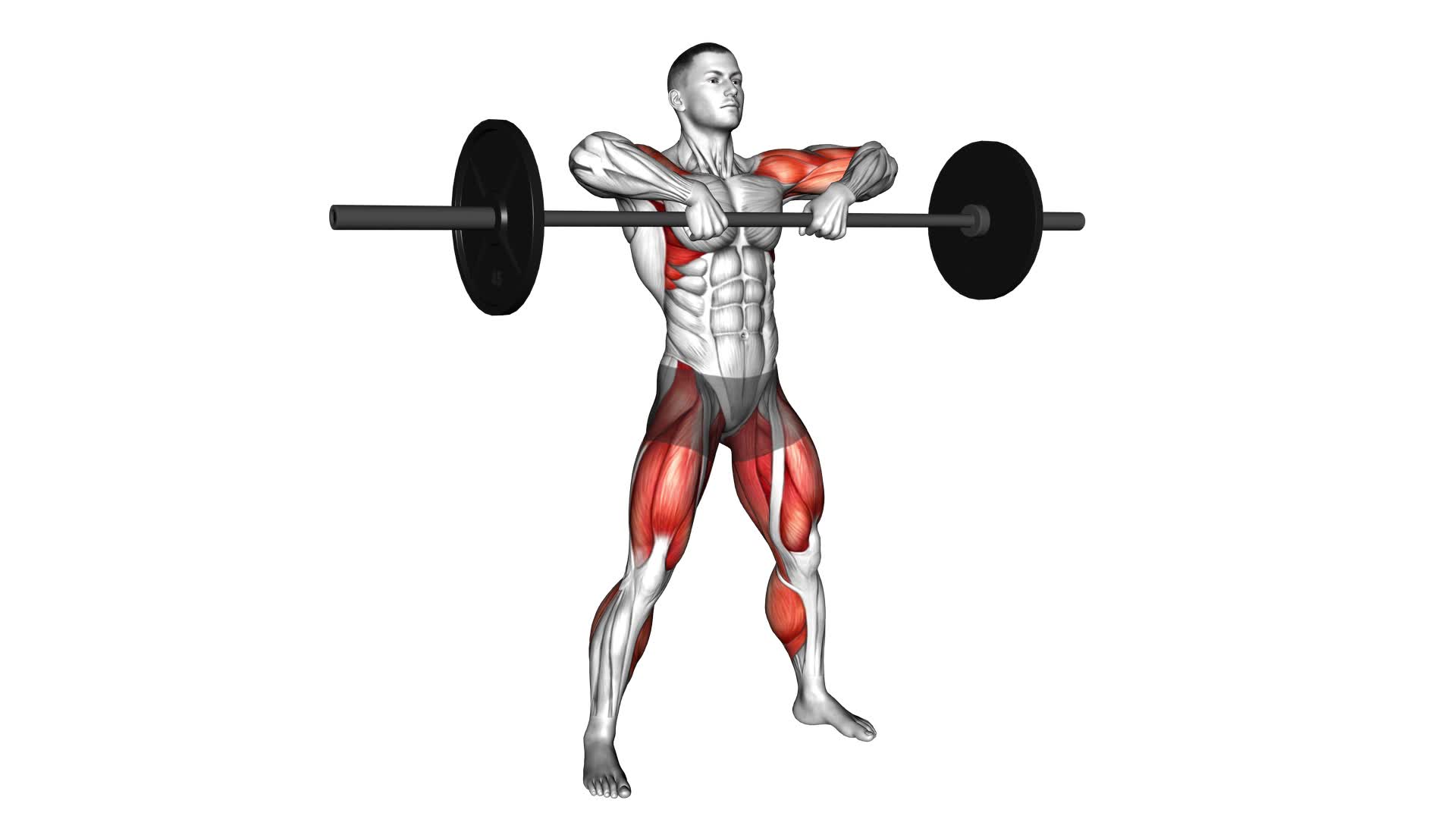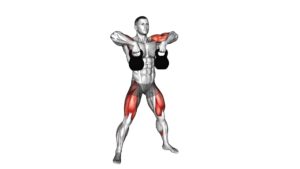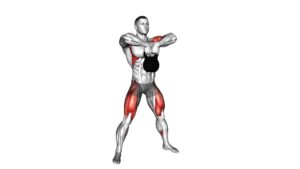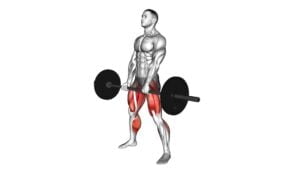Sumo Deadlift High Pull – Video Exercise Guide & Tips

Looking to add a new exercise to your routine? Check out the Sumo Deadlift High Pull!
Watch This Exercise Video
This powerful move targets multiple muscle groups and can help improve your strength and explosiveness.
In this article, we'll guide you through the proper form and technique, as well as provide tips for avoiding common mistakes.
Plus, we'll show you variations and modifications to tailor the exercise to your fitness level.
Get ready to take your workout to the next level with the Sumo Deadlift High Pull!
Key Takeaways
- The Sumo Deadlift High Pull targets multiple muscle groups and improves strength and explosiveness.
- It engages both lower body muscles (glutes, quads, hamstrings) and upper body muscles (shoulders, back, arms).
- It promotes cardiovascular fitness and can be a beneficial addition to any workout routine.
- Proper form and technique, such as a wide stance, straight back, and engaging the core, are essential for maximizing the benefits of this exercise and preventing injuries.
Benefits of the Sumo Deadlift High Pull
You can reap several benefits from incorporating the Sumo Deadlift High Pull into your workout routine. This exercise is a compound movement that targets multiple muscle groups, making it an efficient choice for your strength training. One of the main benefits of the Sumo Deadlift High Pull is its ability to improve your overall strength and power. This exercise engages your lower body muscles, such as your glutes, quads, and hamstrings, as well as your upper body muscles, including your shoulders, back, and arms. By performing this movement regularly, you can develop stronger muscles and increase your overall strength.
Another benefit of the Sumo Deadlift High Pull is its impact on your cardiovascular fitness. This exercise elevates your heart rate, promoting cardiovascular endurance and improving your overall fitness levels. Additionally, the Sumo Deadlift High Pull can be modified to suit your fitness level and goals. You can vary the load by using different weights, adjust the tempo to increase or decrease the intensity, or even incorporate explosive movements for more power development. These variations allow you to challenge yourself and progress over time.
Proper Form and Technique for the Sumo Deadlift High Pull
To perform the Sumo Deadlift High Pull with proper form and technique, begin by positioning yourself with a wide stance and gripping the barbell with an overhand grip. This exercise is great for improving hip mobility and developing power in your hips and upper body.
Start by standing with your feet wider than shoulder-width apart, toes pointed slightly outward. Bend your knees and lower your hips, keeping your back straight and chest up. Grab the barbell with an overhand grip, hands placed just outside shoulder-width apart.
As you begin the movement, drive through your heels and push your hips forward, extending your knees and hips simultaneously. As the barbell reaches your knees, explosively pull it upward, leading with your elbows. Keep your core engaged and your back straight throughout the movement.
At the top of the movement, your elbows should be high and outside, with the barbell close to your chin. Lower the barbell back down to the starting position by reversing the movement, controlling the weight as you lower it to the ground.
Common Mistakes to Avoid When Performing the Sumo Deadlift High Pull
One common mistake to avoid when performing the Sumo Deadlift High Pull is improper grip placement. It's crucial to ensure that your hands are correctly positioned on the barbell to avoid injury and maximize muscle activation.
Here are some common mistakes to avoid:
- Gripping the bar too wide: Placing your hands too wide on the bar can put excessive strain on your shoulders and decrease your ability to generate power. It's recommended to position your hands just outside your knees, allowing for a comfortable and secure grip.
- Gripping the bar too tightly: While it's important to have a firm grip on the bar, gripping it too tightly can lead to unnecessary tension in your forearms and restrict proper muscle activation. Find a balance between a secure grip and maintaining a relaxed upper body.
These grip mistakes can significantly affect your performance and increase the risk of injury. By avoiding them, you can ensure proper muscle activation and maintain a safe and effective Sumo Deadlift High Pull.
Now, let's explore some variations and modifications for the Sumo Deadlift High Pull.
Variations and Modifications for the Sumo Deadlift High Pull
When performing the Sumo Deadlift High Pull, you can incorporate variations and modifications to target specific muscle groups and add variety to your workout routine.
One way to modify this exercise is by using different grips. Instead of the traditional overhand grip, you can try using an underhand grip, also known as a supine grip. This grip places more emphasis on the biceps and forearms, giving them a greater workout.
Another variation is the use of equipment options. While the standard Sumo Deadlift High Pull is typically performed with a barbell, you can switch it up by using dumbbells or kettlebells instead. This not only challenges your muscles in a different way but also provides a greater range of motion for your shoulders and upper back. Additionally, using different equipment can help to improve grip strength and stability.
Tips for Incorporating the Sumo Deadlift High Pull Into Your Workout Routine
To incorporate the Sumo Deadlift High Pull into your workout routine, start by focusing on proper form and technique. This will help you prevent injuries and ensure that you activate the right muscles during the exercise. Here are some important tips to keep in mind:
- Use a wide stance: When performing the Sumo Deadlift High Pull, make sure your feet are positioned wider than shoulder-width apart. This will allow you to generate more power and engage your glutes and inner thighs effectively.
- Keep your back straight: Maintaining a neutral spine is crucial to prevent injuries. Engage your core muscles and avoid rounding your back throughout the movement.
- Drive through your heels: As you lift the barbell, push through your heels to activate your hamstrings and glutes. This will help you generate power and maintain stability.
- Engage your upper body: Remember to use your upper body muscles, such as your shoulders and upper back, to perform the pulling motion. Focus on squeezing your shoulder blades together as you lift the barbell.
Frequently Asked Questions
Can the Sumo Deadlift High Pull Be Performed With a Regular Barbell or Is a Specialized Barbell Required?
You don't need a specialized barbell to perform the Sumo Deadlift High Pull. A regular barbell will work just fine for this exercise. The key is to use proper form and technique to target the muscles effectively.
However, if you want to modify the exercise to target specific muscles, you can use different grips or hand positions on the barbell. This allows you to adjust the muscle activation and focus on different areas of your body.
Is the Sumo Deadlift High Pull More Effective for Building Strength or for Cardiovascular Endurance?
The sumo deadlift high pull is an exercise that offers both strength training benefits and cardiovascular benefits. It's a compound movement that targets multiple muscle groups, helping to build overall strength and power.
Additionally, the explosive nature of the exercise promotes cardiovascular endurance and can elevate your heart rate. By incorporating this exercise into your routine, you can enjoy the best of both worlds – improving your strength and cardiovascular fitness simultaneously.
Can the Sumo Deadlift High Pull Be Modified to Target Specific Muscle Groups?
Modified variations of the sumo deadlift high pull can be used to specifically target different muscle groups. By adjusting grip width, foot stance, and hand placement, you can shift the emphasis to muscles like the glutes, hamstrings, or upper back.
These exercise variations offer benefits such as increased muscle activation and improved strength in targeted areas. However, it's important to note that modifying the exercise may also have drawbacks, such as reducing the overall cardiovascular endurance benefits of the movement.
What Are Some Alternatives to the Sumo Deadlift High Pull for Individuals With Limited Mobility or Injuries?
If you have limited mobility or are dealing with injuries, it's important to find alternative exercises that are safe and effective. There are plenty of options available to you.
Limited mobility exercises like seated resistance band exercises or chair yoga can help improve strength and flexibility.
Injury-friendly workouts such as swimming or cycling can provide a low-impact way to stay active.
Remember to consult with a healthcare professional or a certified trainer to find the best alternatives for your specific needs.
How Frequently Should the Sumo Deadlift High Pull Be Incorporated Into a Workout Routine for Optimal Results?
To optimize your results, it's important to consider the frequency of incorporating the sumo deadlift high pull into your workout routine.
This exercise is effective for both strength and cardiovascular endurance.
To strike a balance, aim to include it in your routine 2-3 times per week.
This will allow your muscles to recover while still challenging them enough to see improvements.
Remember to listen to your body and adjust the frequency based on your individual fitness level and goals.
Conclusion
In conclusion, the sumo deadlift high pull is a highly beneficial exercise that targets multiple muscle groups and improves overall strength and power.
By performing this exercise with proper form and technique, you can avoid common mistakes and maximize its effectiveness.
Additionally, there are variations and modifications available for individuals of different fitness levels.
Incorporating the sumo deadlift high pull into your workout routine can help you achieve your fitness goals and enhance your overall performance.

Author
Years ago, the spark of my life’s passion ignited in my mind the moment I stepped into the local gym for the first time. The inaugural bead of perspiration, the initial endeavor, the very first surge of endorphins, and a sense of pride that washed over me post-workout marked the beginning of my deep-seated interest in strength sports, fitness, and sports nutrition. This very curiosity blossomed rapidly into a profound fascination, propelling me to earn a Master’s degree in Physical Education from the Academy of Physical Education in Krakow, followed by a Sports Manager diploma from the Jagiellonian University. My journey of growth led me to gain more specialized qualifications, such as being a certified personal trainer with a focus on sports dietetics, a lifeguard, and an instructor for wellness and corrective gymnastics. Theoretical knowledge paired seamlessly with practical experience, reinforcing my belief that the transformation of individuals under my guidance was also a reflection of my personal growth. This belief holds true even today. Each day, I strive to push the boundaries and explore new realms. These realms gently elevate me to greater heights. The unique combination of passion for my field and the continuous quest for growth fuels my drive to break new ground.







